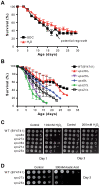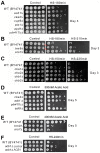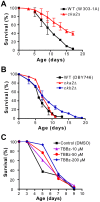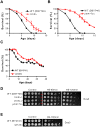Genome-wide screen in Saccharomyces cerevisiae identifies vacuolar protein sorting, autophagy, biosynthetic, and tRNA methylation genes involved in life span regulation
- PMID: 20657825
- PMCID: PMC2904796
- DOI: 10.1371/journal.pgen.1001024
Genome-wide screen in Saccharomyces cerevisiae identifies vacuolar protein sorting, autophagy, biosynthetic, and tRNA methylation genes involved in life span regulation
Abstract
The study of the chronological life span of Saccharomyces cerevisiae, which measures the survival of populations of non-dividing yeast, has resulted in the identification of homologous genes and pathways that promote aging in organisms ranging from yeast to mammals. Using a competitive genome-wide approach, we performed a screen of a complete set of approximately 4,800 viable deletion mutants to identify genes that either increase or decrease chronological life span. Half of the putative short-/long-lived mutants retested from the primary screen were confirmed, demonstrating the utility of our approach. Deletion of genes involved in vacuolar protein sorting, autophagy, and mitochondrial function shortened life span, confirming that respiration and degradation processes are essential for long-term survival. Among the genes whose deletion significantly extended life span are ACB1, CKA2, and TRM9, implicated in fatty acid transport and biosynthesis, cell signaling, and tRNA methylation, respectively. Deletion of these genes conferred heat-shock resistance, supporting the link between life span extension and cellular protection observed in several model organisms. The high degree of conservation of these novel yeast longevity determinants in other species raises the possibility that their role in senescence might be conserved.
Conflict of interest statement
The authors have declared that no competing interests exist.
Figures








References
-
- Longo VD, Finch CE. Evolutionary medicine: from dwarf model systems to healthy centenarians. Science. 2003;299:1342–1346. - PubMed
-
- Kenyon C. A conserved regulatory system for aging. Cell. 2001;105:165–168. - PubMed
-
- Fabrizio P, Longo VD. The chronological life span of Saccharomyces cerevisiae. Methods Mol Biol. 2007;371:89–95. - PubMed
-
- Mortimer RK. Life span of individual yeast cells. Nature. 1959;183:1751–1752. - PubMed
Publication types
MeSH terms
Substances
Grants and funding
LinkOut - more resources
Full Text Sources
Other Literature Sources
Molecular Biology Databases

